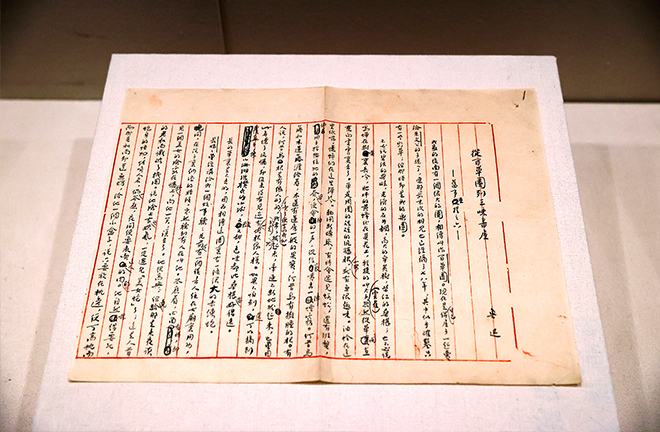Manuscripts open new window for literary studies

A page of a manuscript by Chinese writer Lu Xun in the National Library of China in Beijing Photo: CFP
In September 2021, a new edition of a complete set of manuscripts by Lu Xun was published, including his essays, drafts for translation, letters, diaries, notes on ancient documents, and other writings. Many of these have been released for the first time, providing a massive trove of source documents for academia and readers to better understand Lu Xun.
At the same time, manuscript research has been brought back into the public eye, which has opened a new window for reviewing literary writers. How to better recognize, preserve, study, and utilize manuscripts has contributed a new topic in the field of literature research.
Unique value
The writing of a manuscript creates a warm connection between the author and his or her native language, said Xu Qiang, a professor from the Research Center for the Manuscript Document of New Literature at Northeast Normal University. The manuscript itself displays the generation process of an article. The generative, dynamic, and emotional nature of handwriting and the expressiveness of writing itself are difficult to keep in finished works. These attributes can only be felt in manuscripts.
Manuscripts not only have informative value about authors and their works, but also have aesthetic significance. Many writers’ manuscripts are fine artworks. Apart from the manuscripts of ancient scholars, those of modern masters such as Lu Xun, Ye Shengtao, Mao Dun, and Fu Lei all have unique aesthetic value. The relation between the aesthetics of writing and that of finished works has not been fully explored, a field of inquiry that must be conducted through manuscripts.
All manuscripts are literature, and some are even the only existing forms of certain works. For example, the writer Wang Zengqi wrote a large number of traditional poems and couplets in the 1980s. Many were impromptu oral creations, spur-of-the-moment writings, or poems inscribed on paintings as gifts, without transcripts or publications.
According to Wang Xirong, a professor from the School of Humanities at Shanghai Jiao Tong University, through examining various manuscripts’ morphology, calligraphic style, stylistic change, and calligraphic pattern, we can observe the historical ethos and style of writing patterns, the development trajectory of calligraphy, and calligraphic prospects. From the paper, material, shape, and writing habits in manuscripts, we can see such historical imprints as the fashion of the era, the mode of cultural production, and the appearance of material life.
This is why it is worth publishing a collection of manuscripts by famous writers, in addition to their regular complete works. Though The Complete Works of Lu Xun includes all of Lu Xun’s works, his manuscripts have been repeatedly compiled and published. The latest published complete set of manuscripts by Lu Xun target almost all of his handwritten objects, through which readers and researchers can approach a real Lu Xun from multiple dimensions.
New research paths
In recent years, manuscript research has become a new academic growth point in literature research, with diverse research objects and methods.
Shu Xincheng was a famous modern publisher and educator. His work and social contacts involved nearly half of the history of modern Chinese culture. In Xu’s view, Shu Xincheng kept a diary all the year round which was not a brief memo like Lu Xun’s, but a detailed description and analysis of each day, containing rich historical materials. Extant manuscripts span more than 50 years, totaling around 4.5 million characters, which can be said to be a form of large-scale diary literature. They were mainly written in xingshu (running script) and caoshu (cursive script), which, without compilations, can hardly be effectively used by ordinary researchers due to strong personality characteristics.
There are many ways to promote manuscript research, such as by studying the manuscripts of authors’ relatives, Xu said. The publication of the photocopy of Wang Naiyu’s diary is of great significance in reviewing Wang Guowei. Wang Naiyu, Wang Guowei’s father, had a deep accumulation of traditional learning and was well versed at painting and calligraphy. A lot of information about Wang Guowei, contained in his father’s diary, was previously unknown to researchers.
Literary morphology focuses on the external form and internal structure of literary works, whose research method is of great significance to manuscript research. Morphology used to be a discipline which referred specifically to the study of the nature of biological forms, which was introduced into literary studies in the middle of the 20th century. Thus literary morphology came into being, yet its application in manuscript research is still in its infancy.
In order to derive more internal information from manuscripts by Lu Xun, Wang Xirong tried to use the concepts and methods of literature morphology, research Lu Xun’s manuscripts from a morphological perspective, and investigate the formation process and approach of his manuscript morphology. In this way, scholars can decipher more about Lu Xun’s composition, the basic characteristics of his manuscript forms and part of the ways they were created, and his writing habits, helping readers feel a more real Lu Xun.
The last historical material of modern literature exists in manuscript archives, said Shen Weiwei, a professor from the School of Liberal Arts at Nanjing University. Archives include national archives, institutional archives, and individual archives. In terms of authenticity, manuscript archives rank first among published letters, diaries, autobiographies or memoirs, and biographies. A manuscript archive can complement existing research, or challenge and even subvert established research.
Over the years, in order to unlock the manuscript archive of modern and contemporary writers, Shen Weiwei has been searching for relevant materials at home and abroad. In his opinion, primary materials not only demonstrate a strong sense of historical scenes and historical relevance in the middle of authors’ writing, but also hold the “discourse power” to interpret their writing and thinking process.
Edited by YANG LANLAN

 PRINT
PRINT CLOSE
CLOSE